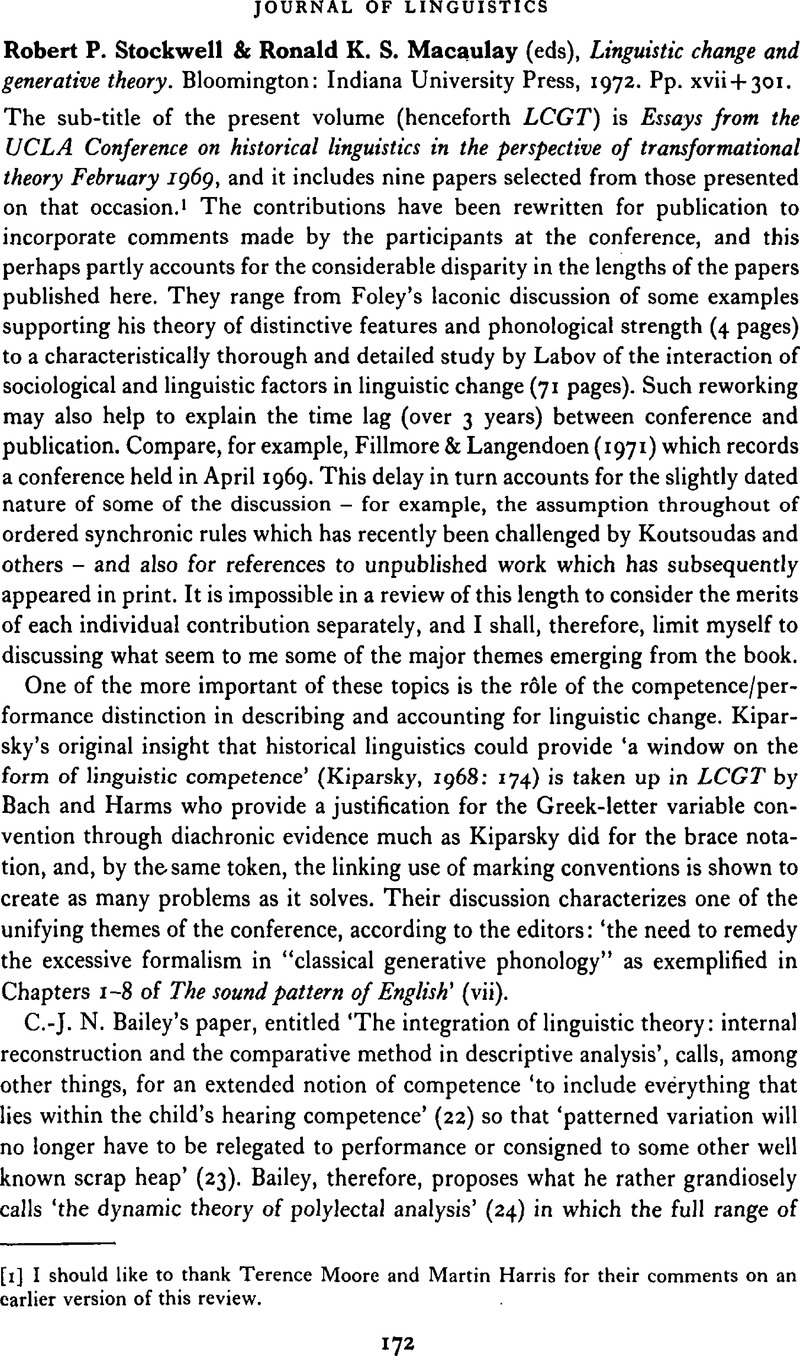No CrossRef data available.
Article contents
Robert P. Stockwell & Ronald K. S. Macaulay (eds), Linguistic change and generative theory. Bloomington: Indiana University Press, 1972. Pp. xvii + 301.
Published online by Cambridge University Press: 28 November 2008
Abstract
An abstract is not available for this content so a preview has been provided. Please use the Get access link above for information on how to access this content.

- Type
- Reviews
- Information
- Copyright
- Copyright © Cambridge University Press 1974
References
REFERENCES
Bailey, C.-J. N. (1970). A new intonation theory to account for pan-English and idiom-particular patterns. Papers in linguistics 2. 522–604.Google Scholar
Bever, T. G. (1970a). The cognitive basis for linguistic structures. In Hayes, J. (ed.), Cognition and the development of language. New York: Wiley & Sons.Google Scholar
Bever, T. G. (1970b). The influence of speech performance on linguistic competence. In D'Arcais, Flores G. & Levelt, W. (eds), Advances in psycholinguistics. Amsterdam: North Holland.Google Scholar
Bever, T. G. & Langendoen, D. T. (1971). A dynamic model of the evolution of language. Lin 2. 433–465.Google Scholar
Cazden, C. B. (1968). The acquisition of noun and verb inflections. Child development 39. 433–448.CrossRefGoogle ScholarPubMed
Cohen, V. B. (1971). Foleyology. In Papers from the seventh regional meeting of the Chicago linguistic society. University of Chicago Press.Google Scholar
Fillmore, C. J. & Langendoen, D. T. (eds) (1971). Studies in linguistic semantics. New York: Holt, Rinehart & Winston.Google Scholar
King, R. D. (1969). Historical linguistics and generative grammar. Englewood Cliffs, N.J.: Prentice-Hall.Google Scholar
Kiparsky, P. (1965). Phonological change. Bloomington: Indiana University Linguistics Club.Google Scholar
Kiparsky, P. (1968). Linguistic universals and linguistic change. In Bach, E. & Harms, R. T. (eds), Universals in linguistic theory. New York: Holt, Rinehart & Winston.Google Scholar
Kurylowicz, J. (1945–1949). La nature des procès dits ‘analogiques’. In Hamp, E. P. et al. (eds) (1966), Readings in linguistics II. Chicago: Chicago University Press.Google Scholar
Labov, W. P. (1969). Contraction, deletion, and inherent variability of the English copula. Lg 45. 715–762.Google Scholar
Lass, R. (1972). How intrinsic is content? Markedness, sound change, and ‘family universals’. Edinburgh Working papers in linguistics 1. 42–67.Google Scholar
Manczak, W. (1958). Tendances générales des changements analogiques. Lingua 7. 298–325, 387–420.CrossRefGoogle Scholar
Reighard, J. (1971). Some observations on syntactic change in verbs. In Papers from the seventh regional meeting of the Chicago linguistic Society. University of Chicago Press.Google Scholar
Slobin, D. I. (1966). The acquisition of Russian as a native language. In Smith, F. & Miller, G. A. (eds), The genesis of language. Cambridge, Mass.: MIT Press.Google Scholar


